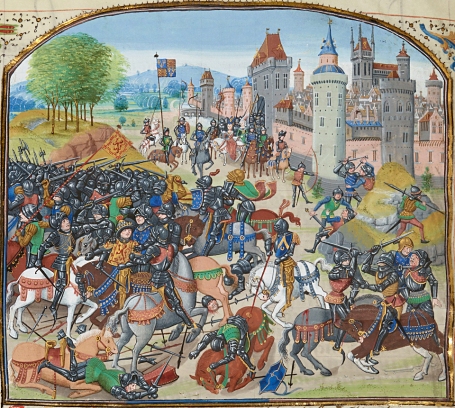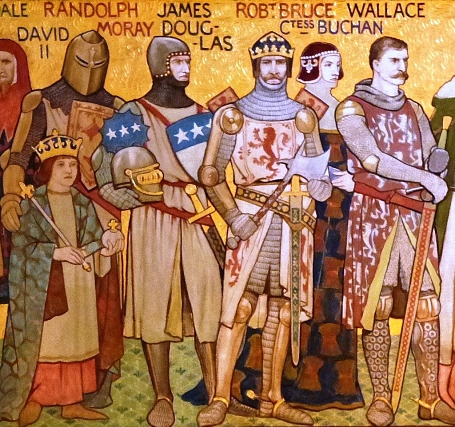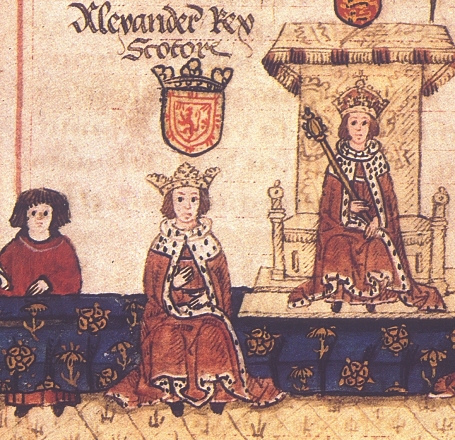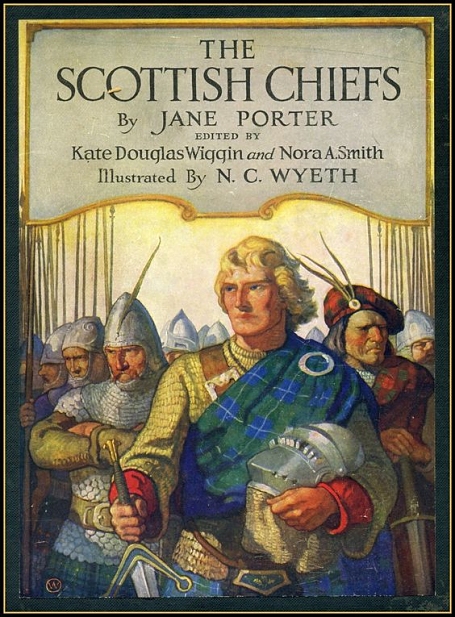The Life and Heroick Actions of the Renoun'd Sir William Wallace,
General and Governour of Scotland
by William Hamilton of Gilbertfield
Synopsis (Continued)
July: Flowers are in bloom, beasts graze in the pastures, the streams are full of fish, yet the people of Scotland are wanting. Having been harassed by the English they've had no time to plant their fields. By August there is a lack of food. The English, however, are well fed having brought in supplies by wagons. They're cheerful, strong and confident that no Scots can withstand them – until they hear the news that Wallace has escaped from prison, which casts them down "into the dumps." Percy, when he hears the news that Wallace is still alive, says that the English have much to dread. He thinks Wallace should be paid off with land and gold to be brought into King Edward's peace, otherwise he'll free Scotland from English rule.
Meanwhile, Wallace is in Riccarton, plotting to take revenge on the English for the deaths of his father and brother. He gathers a group of family and supporters: his cousins – sons of Richard Wallace – Adam, Richard and Simon. Adam, at eighteen, is the eldest of the three. Also in this band is Cleland, Robert Boyd, and Edward Little – the son of Wallace's previously unmentioned sister.
Clad in armor, they ride out to Mauchlin Moor, where they learn from friends that a knight named Fenwick is leading a convoy including wagons of food and other supplies from Carlisle, in northern England, to Ayr. Wallace and his men ride to a grove near Loudon Hill to keep watch for the English supply wagon, settling in for the night. A Scot that lives nearby brings them food and news: the English sent an advance party of riders into Ayr, leaving the rest of the party to follow. He tells Wallace that they're probably in Annandale.
Here there is a break in the action to describe how Wallace is attired. He's wearing summer clothing, that being all he's had since he escaped prison, but is protected by a habergeon (a light sleeveless coat of chain mail), a steel helmet (probably a bowl-type Norman helmet), plate-armor gloves, a doublet with a steel collar, and a cloak, with which he covers his face when among strangers.
Wallace and his men go now to Loudon Hill. Wallace remarks that this is the place where his father and brother were killed, and once again vows vengeance. Fenwick arrives with his convoy of 180 men; Wallace has amassed a force of 50 men. At a ravine, Wallace and his men partially block the passage with rocks and boulders; they turn their horses loose and prepare to fight on foot. As the English make their way through the pass they are attacked with spears. Fenwick is identified as responsible for Wallace's father and brothers death; he is killed in the thick of battle. One of Wallace's men, Robert Boyd, is almost killed, but Wallace is nearby and comes to his rescue; Adam Wallace kills a knight named Beaumont.
Three Scots die in the battle – one from Cunningham, two from Kyle. One hundred of the Englishmen are killed; the rest flee, driving the baggage train into Clyde Forest nearby. Wallace's men pursue, hang the soldiers, and free the women and priests. They take two hundred horses, and armor, weapons, food and wine from the wagons. The English survivors make their way to Ayr, where they report to Percy what has happened. Percy again states what a threat Wallace is to the English hold on Scotland, and says that now they'll have to send their provisions by sea.
Wallace and his men distribute the supplies they've taken from the English baggage train, staying in Clyde Forest for three days. Meanwhile, Percy goes to Glasgow and summons a council of lords. Though these lords command 10,000 men, none are willing to go up against Wallace in battle.
Aymer de Valance, Earl of Pembroke, who has come to the council from Bothwell, says they must devise a plan to make peace with Wallace. Percy replies that Wallace will never agree to a truce, that Wallace doesn't believe killing Englishmen is a sin. Valance then suggests they use Wallace's uncle, Sir Ranald Crawford; if he can't get his nephew to enter into a truce with the English, then Crawford will be forced to forfeit his lands to the the English until he accomplishes the task. Crawford is brought to the council and told to secure Wallace's peace or he'll be imprisoned in London.
Crawford replies that Wallace won't listen to him – they've killed Wallace's kin, they've thrown him into prison, there's nothing that can be said to bring him to peace with the English. Percy counters with an offer of peace for all Scots: if Crawford secures Wallace's peace, then Percy gives his word and seal that not only will Wallace be left alone, but all Scots will live in peace.
Crawford, knowing he cannot withstand their demands, agrees and heads to Clyde Forest where he feasts with Wallace and his men on food and wine from the English baggage train. After they've eaten, Crawford tells Wallace the reason for his visit. He counsels Wallace to keep the peace with the English for a season. Wallace's men – Boyd, Cleland and Adam Wallace – all state their agreement; Wallace gives his agreement and they go their separate ways. Wallace returns to Crosby to live with Sir Ranald.
Wallace becomes restless in Crosby; he takes fifteen men with him to the town of Ayr. In disguise, they pass through the town gates and see an English fencer near the armory with his buckler (a small, round shield either carried or worn on the arm) in hand. Wallace stands with some onlookers; the fencer notices him and challenges him. They exchange mild insults, then Wallace attacks and cuts right through the shield and the man's arm.
The women in the crowd cry out that the fencer has been killed, and Wallace and his fifteen men are suddenly surrounded by 160 English men at arms. Wallace and his men fight them off, retrieve their horses and ride for Laglan Woods. Twenty-nine English soldiers were killed, three of them kin of Percy's. Percy sends a herald with a message to Ranald Crawford, telling him to keep Wallace from the town, market and fairs – anywhere that Englishmen gathered.
When night falls Wallace leaves Laglan Woods and rides back to Crosby, where Sir Ranald lives. Ranald shows Wallace the writ Percy has sent and asks him to abide by the truce. Wallace agrees, saying that as long as he's staying with Sir Ranald, he'll do no more harm. Wallace stays seventeen days, but though he obeys his uncle and the writ Percy has sent, his mind is tormented by thoughts of freedom from the English.
In September the English nobility who hold lands and positions in Scotland convene a council in Glasgow. Sir Ranald Crawford is summoned to attend; William Wallace goes with him. They take only three servants with them so the English won't misconstrue their intent. On the way to Glasgow Percy's convoy passes by with two men on foot and three on horse. Their horses are tired from the journey and the horsemen demand Sir Ranald's horses. When Ranald refuses, Percy's men take the horses by force.
Wallace restrains his rage, but after a short time leaves his uncle and rides ahead. At Cathcart he lies in wait for Percy's men. Wallace kills three of them; the other two flee. Wallace takes what money and supplies are left behind and rides to Lennox where he is received by Malcolm, Earl of Lennox, a great Scottish chief.
Earl Malcolm tells Wallace that he can stay in Lennox, and even offers Wallace command of his men. Wallace, thinking only of fighting to free Scotland, refuses the sanctuary of Lennox. He gathers a force from Malcolm's men which include Stephen, an Irish exile, Fawdon, a violent man "of dreadful size," and sixty more men. They ride north to Gargunnock Hill, where the English have taken a pele tower (a small roughly-built fortified structure of oblong plan, between two and four stories high) and stocked it with men and food. Wallace is determined to take the tower, if it can be done without too much noise. He sends spies to assess the situation and decides to attack that night.
Wallace sends his men at arms to break a bar that secures the outmost door, but they're unable to get in. Wallace, impatient at the delay, forcefully tears the bar from the door, breaking the gate and causing part of the wall to collapse. His men are impressed at his ability to "do more than twenty could perform." They rush into the building; Wallace kills the watchman and the captain. His men slaughter the rest of the Englishmen inhabiting the building and take the gold and provisions for themselves, but let the women and children go free.
Wallace and his men stay at the pele for four days. On the fifth day they march north, crossing the Teith and the Earn in an attempt to learn the movements of any English army that may be in the vicinity. They retreat to Methven Forest where they find the hunting good. Wallace is pleased with the location, as his men are well fed, but takes none for himself. He doesn't care how hungry or cold he gets – his mind is only on Scotland and his hatred of the English.
Becoming restless at sitting idle in Methven Forest, Wallace decides to go St. Johnston (Perth.) He takes seven men with him, leaving Stephen of Ireland in charge of the rest. Wallace gives a false name and is admitted into the town. He quickly establishes a romantic relationship with a young woman and, from her, gets information about the Englishmen in the area.
Wallace learns that an "aged, cruel" English knight named Butler is holding Kinclaven Castle. He returns to Methven, rallies his men and plans an ambush. They creep "silently and slow" along the banks of the Tay, but the English see the Scots approaching and a battle ensues, during which Wallace kills Butler. The remaining English soldiers flee, leaving sixty Englishmen dead. The castle yields to Wallace after a brief siege. Wallace and his men burn it and retreat to Short-Wood Shaws.
The English in St. Johnston, hearing of Wallace's attack on the castle assemble a thousand men and march toward Short-Wood Shaws. Part of the English force is led by Sir John Butler, whose father Wallace killed at Kinclaven. Butler swears vengeance on Wallace, and sends for Lorraine from Guthrie who was a friend of his father's.
A great battle ensues, during which Butler, while fighting with Wallace under a tree, is struck in the head by a falling branch and dies instantly. Lorraine, enraged, attacks Wallace and is killed. By the end of the battle seven Scots have died; 120 English are killed. Fearing that the English will send in more men Wallace and his men retreat to Methven Forest and then moved on to Elcho park.
Wallace decides to return to Perth to see the young lady who told him that Butler held Kinclaven Castle. She is referred to in this chapter as his leman (sweetheart, lover, mistress). He disguises himself in a friar's robe, meets up with her in Perth and spends the night with her. They agree that he will return another day. While he's away, the English bribe her with gold to betray Wallace.
When Wallace returns at a later date, the young lady is overcome with guilt and tells him of her deal with the English. He forgives her, then dresses himself in women's clothes and leaves. He passes the English watchmen at the gate, but two of them are suspicious of the "woman's" size, so they follow. As soon as they are out of earshot and sight of the rest of the watch, Wallace turns around, pulls out his sword, and kills them. He then returns to his men in the forest.
The ballad, The Life and Heroick Actions of the Renoun'd Sir William Wallace, General and Governour of Scotland, by William Hamilton of Gilbertfield, 1722, is in the public domain.

The Kingdom of England and the Kingdom of Scotland fought dozens of battles with each other. They fought typically over land, particularly Berwick-Upon-Tweed, and the Anglo-Scottish border frequently changed as a result. Read more at Wikipedia.

The First War of Scottish Independence was the initial chapter of engagements in a series of warring periods between English and Scottish forces lasting from the invasion by England in 1296 ... Read more at Wikipedia.

Edward I (1239-1307), also known as Edward Longshanks and the Hammer of the Scots, was King of England from 1272 to 1307. Read more at Wikipedia.

Digitized version of The Scottish Chiefs, by Jane Porter, a novelization published in 1921 by Charles Scribner's Sons, about William Wallace and the First Scottish War of Independence. Read online at archive.org.